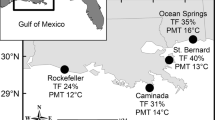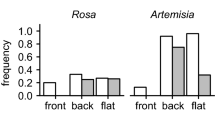Summary
Seedling recruitment in salt marsh plant communities is generally precluded in dense vegetation by competition from adults, but is also relatively rare in disturbance-generated bare space. We examined the constraints on seedling recruitment in New England salt marsh bare patches. Under typical bare patch conditions seed germination is severely limited by high substrate salinities. We examined the germination requirements of common high marsh plants and found that except for one notably patch-dependent fugitive species, the germination of high marsh plants is strongly inhibited by the high soil salinities routinely encountered in natural bare patches. Watering high marsh soil in the greenhouse to alleviate salt stress resulted in the emergence of up to 600 seedlings/225 cm2. The vast majority of this seed bank consisted of Juncus gerardi, the only common high marsh plant with high seed set. We tested the hypothesis that salt stress limits seedling contributions to marsh patch secondary succession in the field. Watering bare patches with fresh water partially alleviated patch soil salinities and dramatically increased both the emergence and survival of seedlings. Our results show that seedling recruitment by high marsh perennial turfs is limited by high soil salinities and that consequently their population dynamics are determined primarily by clonal growth processes. In contrast, populations of patch-dependent fugitive marsh plants which cannot colonize vegetatively are likely governed by spatially and temporally unpredictable windows of low salinities in bare patches.
Similar content being viewed by others
References
Amen RD, Carter GE, Kelly RJ (1970) The nature of seed dormancy and germination in the salt marsh grass Distichlis spicata. New Phytologist 69: 1005–1013
Ayre DJ (1984) The effects of sexual and asexual reproduction on geographic variation in the sea anemone Actinia tenebrosa. Oecologia 62: 222–229
Bazzaz FA (1979) The physiological ecology of plant succession. Annual Rev Ecol System 10: 351–371
Bazzaz FA (1990) Plant-plant interactions in successional environments. In: Grace J, Tilman D (eds) Perspectives on plant competition. Academic Press, San Diego
Beadle NCW (1952) Studies in halophytes. I. The germination of the seed and establishment of the seedlings of five species of Atriplex in Australia. Ecology 33: 49–62
Bertness MD (1991) Interspecific interactions among high marsh perennials in a New England salt marsh. Ecology 72: 125–137
Bertness MD, Ellison AM (1987) Determinants of pattern in a New England salt marsh plant community. Ecol Monogr 57: 129–147
Bertness MD, Gough L, Shumway SW (1992) Salt tolerances and the distribution of fugitive salt marsh plants. Ecology 73: 1842–1851
Bertness MD, Shumway SW (1992a) Consumer driven pollen limitation of seed production in New England salt marsh grasses. Am J Bot 79: 288–293
Bertness MD, Shumway SW (1992b) Competition and facilitation in marsh plants. Am Natural (in press)
Bertness MD, Wise C, Ellison AM (1987) Consumer pressure and seed set in a salt marsh perennial plant community. Oecologia 71: 190–200
Bierzychudek P (1981) Pollinator limitation of plant reproductive effort. Am Natural 117: 838–840
Connell JH (1985) The consequences of variation in initial settlement vs. post-settlement mortality in rocky intertidal communities. J Exp Mar Biol Ecol 93: 11–45
Ellison AM (1987) Effects of competition, disturbance, and herbivory on Salicornia europaea. Ecology 68: 576–586
Ellison AM (1991) Ecology of case-bearing moths (Lepidoptera: Coleophoridae) in a New England salt marsh. Ecol Entomol 20(3): 857–864
Fenner M (1985) Seed Ecology. Chapman & Hall, London
Gaines SD, Roughgarden J (1987) Fish in offshore kelp forests affect recruitment to intertidal barnacle populations. Science 235: 479–481
Grime JP (1989) In: Leck MA, Parker VT, Simpson RL (eds) Ecology of Soil Seed Banks. Academic Press, San Diego
Hansen DJ, Dayanandan P, Kaufman PB, Brotherson JD (1976) Ecological adaptations of salt marsh grass, Distichlis spicata (Gramineae), and environmental factors affecting its growth and distribution. Am J Bot 63: 635–650
Harper JL (1977) Population Biology of Plants. Academic Press, London
Hartman J (1988) Recolonization of small disturbance patches in a New England salt marsh. Am J Bot 75: 1625–1631
Hartman J, Caswell H, Valiela I (1983) Effects of wrack accumulation on salt marsh vegetation. Proceedings of the 17th European Marine Biology Symposium, Brest, France. 99–102
Hopkins DR, Parker VT (1984) A study of the seed bank of a salt marsh in Northern San Francisco Bay. Am J Bot 71: 348–355
Hughes TP (1985) Life histories and population dynamics of early successional corals. 5th International Coral Reef Congress, Tahiti. 4: 101–106
Hughes TP, Jackson JBC (1985) Population dynamics and life histories of foliaceous corals. Ecol Monogr 55: 141–166
Jackson JBC, Hughes TP (1985) Adaptive strategies of coral-reef invertebrates. Am Scien 73: 265–274
Jefferies RL (1981) Population biology of the salt marsh annual Salicornia europaea. J Ecol 69: 17–31
Leck MA, Parker VT, Simpson RL (1989) Ecology of Soil Seed Banks. Academic Press, San Diego
Louda SM (1982) Distribution ecology: variation in plant recruitment over a gradient in relation to insect seed predation. Ecol Monogr 52: 25–41
Louda SM (1983) Seed predation and seedling mortality in the recruitment of a shrub, Haplopappus venetus (Asteraceae), along a climatic gradient. Ecology 64: 511–521
Louda SM (1989) Predation in the dynamics of seed regeneration. In: Leck MA, Parker VT, Simpson RL (ed) Ecology of Soil Seed Banks. Academic Press, San Diego.
Mendelssohn IA, Mckee KL, Patrick WH (1981) Oxygen deficiency in Spartina alterniflora roots: metabolic adaptation to anoxia. Science 214: 439–441
Milton WEJ (1939) The occurrence of buried viable seeds in soils at different elevations and on a salt marsh. J Ecol 27: 149–159
Nixon SW (1982) The ecology of New England high salt marshes: A community profile. U.S. Fish and Wildlife Service, Washington, D.C
Partridge TR, Wilson JB (1987) Salt tolerance of salt marsh plants of Otago, New Zealand. New Zealand J Bot 25: 559–566
Rice WR (1989) Analyzing tables of statistical tests. Evolution 42: 223–225
Ross MA, Harper JL (1972) Occupation of biological space during seedling establishment. J Ecol 60: 77–88
Roughgarden J, Gaines S, Iwasa Y (1984) Dynamics and evolution of marine populations with pelagic larval dispersal. In: May RM (ed) Exploitation of marine communities
Roughgarden J, Gaines SD, Pacala SW (1987) Supply side ecology: the role of physical transport processes. Organization of communities: past and present. Proceedings of the British Ecological Society Symposium, Abersyth, Wales
Schmitt J, Ehrhardt DW (1990) Enhancement of inbreeding depression by dominance and suppression in Impatiens capensis. Evolution 44: 269–278
Sokal RR, Rohlf FJ (1981) Biometry. W.H. Freeman and Company, NY
Stephenson AG (1981) Flower and fruit abortion: proximate causes and ultimate functions. Annual Rev Ecol System 12: 253–279
Underwood AJ, Denley EJ (1984) Paradigms, explanations and generalizations in models for the structure of intertidal communities on rocky shores. In: Strong DR, Simberloff D, Abele LG, Thistle AB (eds) Ecological communities: conceptual issues and the evidence. Princeton University Press, Princeton, NJ
Ungar IA (1978) Halophyte seed germination.Bot Rev 44: 233–264
Ungar IA (1987) Population biology of halophyte seeds. Bot Rev 53: 301–334
Ungar IA, Riehl TE (1980) The effect of seed reserves on species composition in zonal halophyte communities. Bot Gazette 141: 447–452
Valk AG van der (1981) Succession in wetlands: a Gleasonian approach. Ecology 62: 688–696
Wulff J (1991) Population dynamics, asexual propagation, and genotype success in coral reef sponges. J Exp Mar Biol Ecol 149: 227–247
Author information
Authors and Affiliations
Rights and permissions
About this article
Cite this article
Shumway, S.W., Bertness, M.D. Salt stress limitation of seedling recruitment in a salt marsh plant community. Oecologia 92, 490–497 (1992). https://doi.org/10.1007/BF00317840
Received:
Accepted:
Issue Date:
DOI: https://doi.org/10.1007/BF00317840




